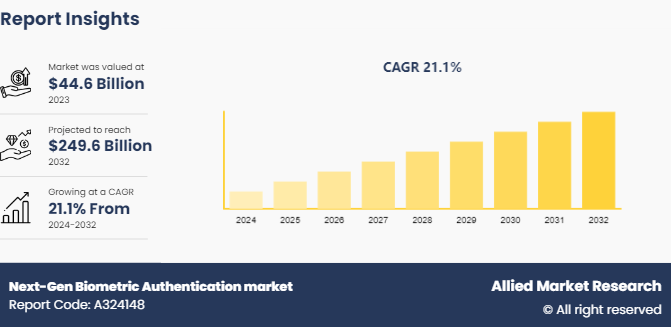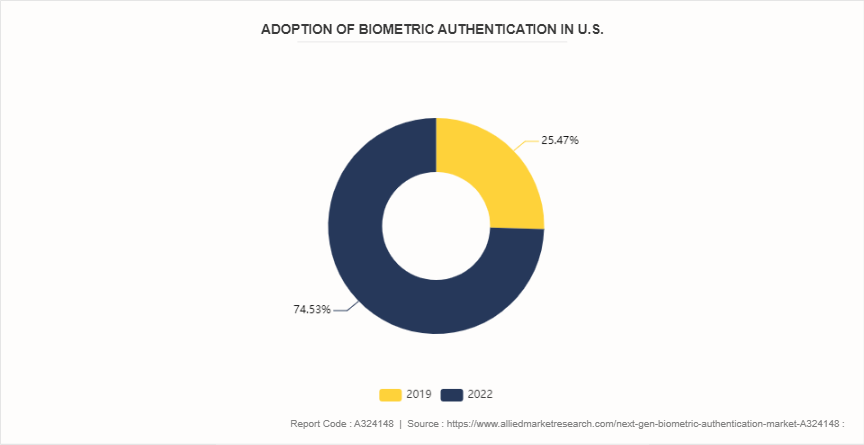Next-Gen Biometric Authentication Market Research, 2032
The global next-gen biometric authentication market size was valued at $44.6 billion in 2023, and is projected to reach $249.6 billion by 2032, growing at a CAGR of 21.1% from 2024 to 2032. Next-gen biometric authentication refers to advanced security systems that use unique biological traits, such as fingerprints, facial recognition, or iris patterns, to verify identities, enhancing security and user convenience.

Market Introduction and Definition
Next-generation biometric authentication refers to advanced methods of verifying an individual's identity using authentication/biometric technology, such as fingerprints, facial features, iris patterns, voice recognition, and even behavioral characteristics such as typing patterns. In addition, traditional security measures rely on passwords or PINs, whereas next-gen biometric authentication provides a higher level of security and convenience by utilizing unique physical or behavioral traits that are inherently difficult to replicate or steal. Biometric next-gen authentication technology has rapidly evolved, incorporating artificial intelligence and machine learning to enhance accuracy, speed, and adaptability in various applications ranging from mobile banking to border control.
Key Takeaways
The next-gen biometric authentication market share study covers 20 countries. The research includes a segment analysis of each country in terms of value ($Billion) for the projected period 2024-2032.
More than 1,500 product literatures, industry releases, annual reports, and other such documents of major next-gen biometric authentication industry participants along with authentic industry journals, trade associations' releases, and government websites have been reviewed for generating high-value industry insights.
The study integrated high-quality data, professional opinions and analysis, and critical independent perspectives. The research approach is intended to provide a balanced view of global markets and assist stakeholders in making educated decisions to achieve their most ambitious growth objectives.
Key Market Dynamics
The next-gen biometric authentication market growth is driven by a surge in regulatory requirements across sectors such as banking, healthcare, and government, necessitating advanced identity verification solutions and integration of AI & machine learning in biometric systems. In addition, the key regulatory frameworks, such as the General Data Protection Regulation (GDPR) in Europe and similar data protection laws worldwide, necessitate robust measures to safeguard personal information. This rise in demand for enhanced security measures is a primary driver of the next-gen biometric authentication market. For instance, the banking, stringent Know Your Customer (KYC) norms require reliable identity verification, while in healthcare, regulations ensure patient confidentiality and data integrity. Furthermore. government sectors implement biometrics to enhance national security and streamline citizen services. These regulatory pressures enhance security and boost innovation in biometric technologies to meet compliance standards effectively
However, privacy and data security concerns are significant barriers to the growth of the next-gen biometric authentication market size. As biometric technologies become more widespread, there is a heightened sensitivity regarding the storage and usage of personal biometric data the issues related to security such as data breaches, unauthorized access, and potential misuse of biometric information pose significant challenges and affect both consumers and organizations from adopting these biometric technologies.
Furthermore, technological advancements in artificial intelligence (AI) and machine learning have revolutionized biometric authentication systems by significantly improving their accuracy, reliability, and usability. These innovations enable systems to adapt in real-time, ensuring quick and precise verification across various platforms. Moreover, the AI-driven algorithms enhance the system's ability to recognize and authenticate unique biological or behavioral with greater precision, while also improving resistance to spoofing attempts. This evolution not only enhances security but also enhances user experience by providing seamless and efficient authentication processes in diverse applications, from mobile devices to enterprise systems, which is future expected to drive the growth during the next-gen biometric authentication market forecast period.
Adoption of Biometric Authentication in U.S.
According to GetApp, the adoption of biometric authentication in the U.S. has significantly, growing from 27% in 2019 to 79% in 2022. The substantial show rise in adoption of biometric authentication and trust in biometric technologies for securing sensitive information and facilitating seamless user experiences. In addition, next-Gen Biometric Authentication, which includes advanced modalities such as facial recognition, iris scanning, and behavioral biometrics, drives market trends. The rise in technological advancement driven by integration into smartphones, financial services, healthcare, and governmental applications which supports the growth of next-gen biometric authentication market. The significant leap in adoption rates highlights the increasing confidence of governments, enterprises, and individuals in biometric authentication as a modern security protocols, which creates an opportunity in innovations and a more secure digital ecosystem.

Market Segmentation
The next-gen biometric authentication market is segmented into component, technology, authentication type, end user, and region. On the basis of component, the market is divided into software and services. As per technology, the market is segregated into fingerprint recognition, facial recognition, iris recognition, voice recognition, palm vein recognition, signature recognition and others. On the basis of authentication type, the market is classified into single-factor authentication and multi-factor authentication. On the basis of end user, the market is categorized into government, defense, travel & immigration, home security, banking & financial service, healthcare, and other. Region wise, the market is analyzed across North America, Europe, Asia-Pacific, and LAMEA.
Regional/Country Market Outlook
North America remains at the forefront of the next-gen biometric authentication market, which is propelled by technological advancements, strong focus on security, and substantial investments in research and development. The presence of key market players and a favorable regulatory environment further boost the market in this region.
Furthermore, the next-generation biometric authentication market in the Asia-Pacific region is experiencing significant growth due to rapid urbanization, which drives the need for enhanced security in densely populated areas. In addition, the expanding digital economies in countries such as China, India and Japan led to rise in demand for advanced biometric solutions to secure online transactions and services, thereby supports the market growth. For instance, India’s Aadhaar project, the world’s largest biometric identification system, exemplifies the widespread adoption and potential of biometric technologies. Moreover, the proliferation of smartphones and mobile banking in the region also contributes to the growing demand for biometric authentication solutions.
Industry Trends
In January 2023, U.S. Congress directed the Department of Homeland Security to commission an independent review of DHS’ beleaguered next-generation biometrics system, while also planning a proposed funding increase for the delayed project.
In November 2021, IDEMIA partnered with Federal Bank to design and implement a secure biometric system that offers a smarter and more efficient working environment for employees. In addition, this partnership is expected to address a key operational challenge of the pandemic by reducing contact points. Implementation of this robust, reliable, and powerful access control system reaffirms IDEMIA’s leadership in contactless biometrics for a secure, convenient, and hygienic access control in India.
Competitive Landscape
The major players operating in the next-gen biometric authentication market are CU NextGen, IDEMIA, NEC Corporation, Fujitsu Ltd, Siemens AG, Thales Group, Cross Match Technologies, Fingerprint Cards AB, Suprema Inc., RCG Holdings Limited, and Safran SA.
Recent Key Strategies and Developments in Next-Gen Biometric Authentication Industry
In March 2023, Cerence Inc. launched its latest AI-powered biometrics engine in Cerence Assistant, enhancing personalization and security features for the mobility experience. By leveraging advanced AI technology, Cerence Voice Biometrics offers improved accuracy in creating driver profiles, identifying speakers, and facilitating safer, more personalized interactions with the in-car assistant.
In June 2022, Vision-Box presented its latest solution Seamless Kiosk, which is based on a new generation of biometric innovation and is intended to revolutionize the traveling experience.
Key Sources Referred
European Union Agency for Cybersecurity
National Institute of Standards and Technology
Department of Homeland Security
GetApp
IDEMIA
Key Benefits For Stakeholders
This report provides a quantitative analysis of the market segments, current trends, estimations, and dynamics of the market analysis from 2024 to 2032 to identify the prevailing next-gen biometric authentication market opportunities.
The market research is offered along with information related to key drivers, restraints, and opportunities.
Porter's five forces analysis highlights the potency of buyers and suppliers to enable stakeholders make profit-oriented business decisions and strengthen their supplier-buyer network.
In-depth analysis of the next-gen biometric authentication market segmentation assists to determine the prevailing market opportunities.
Major countries in each region are mapped according to their revenue contribution to the global market.
Market player positioning facilitates benchmarking and provides a clear understanding of the present position of the market players.
The report includes the analysis of the regional as well as global next-gen biometric authentication market trends, key players, market segments, application areas, and market growth strategies.
Next-Gen Biometric Authentication market, by Component Report Highlights
| Aspects | Details |
| Market Size By 2032 | USD 249.6 Billion |
| Growth Rate | CAGR of 21.1% |
| Forecast period | 2024 - 2032 |
| Report Pages | 290 |
| By Component |
|
| By Technology |
|
| By Authentication Type |
|
| By End User |
|
| By Region |
|
| Key Market Players | Siemens AG, NEC Corporation, CU NextGen, Thales Group, Fingerprint Cards AB, Fujitsu Ltd, Cross Match Technologies, Safran SA., IDEMIA, RCG Holdings Limited, Suprema Inc. |
Next-gen biometric authentication refers to advanced security systems that use unique biological traits, such as fingerprints, facial recognition, or iris patterns, to verify identities, enhancing security and user convenience.
The forecast period for next-gen biometric authentication market is 2024 to 2032.
The base year is 2023 in the next-gen biometric authentication market report.
The total market value of next-gen biometric authentication market was $44.6 billion in 2023.
The market value of next-gen biometric authentication market in 2032 is expected to be $249.6 billion.
Loading Table Of Content...



